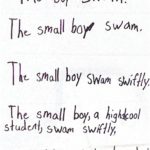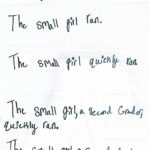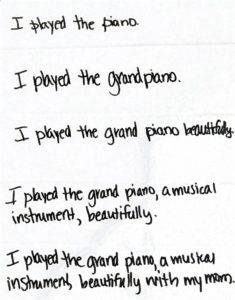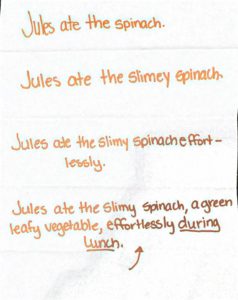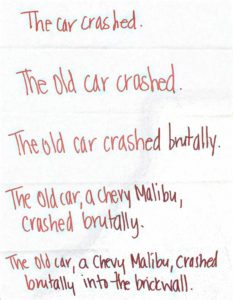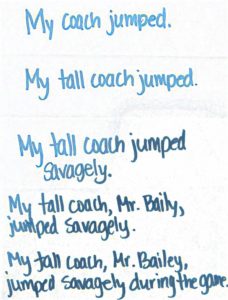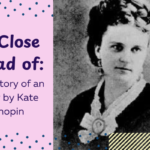** Contact us if you would like Rogers Education Consulting to come to your campus with engaging, evidence-based, and practical professional development **
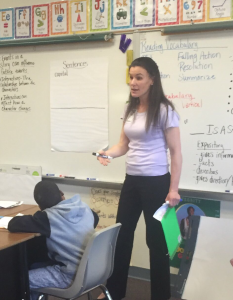 About ten years ago, I read Jeff Anderson’s Mechanically Inclined and it changed writing in my classroom forever! As someone who never felt competent in their own writing, teaching writing was a daily struggle. I found myself relying on the writing program given to me by the school. It consisted of a very large and very dry grammar book, and of course Daily Oral Language (DOL). The kids groaned every time one of the DOLs hit the board. On the inside, I groaned too. It seemed like such a waste of time!
About ten years ago, I read Jeff Anderson’s Mechanically Inclined and it changed writing in my classroom forever! As someone who never felt competent in their own writing, teaching writing was a daily struggle. I found myself relying on the writing program given to me by the school. It consisted of a very large and very dry grammar book, and of course Daily Oral Language (DOL). The kids groaned every time one of the DOLs hit the board. On the inside, I groaned too. It seemed like such a waste of time!
After reading Anderson’s book, I realized I was teaching grammar backward! I was showing incorrect sentences and paragraphs and expecting students to naturally know what was wrong. Now that I write it out, I hear how ridiculous that sounds. Asking students, “does that sound right to you?” won’t work until we have had plenty of time interacting with correct examples of grammar and sentences.
The idea of letting students play with words and sentences kept rolling around in my brain. The students loved doing this. For example, I would have students practice breaking long sentences into small sentences and combine simple sentences together to make longer sentences. I always did this with writing on my mind, so by doing these activities, students learned how to construct compound and complex sentences in their own writing which eliminated the pages of simple sentences that they regularly turned in to me. I recently heard Gina Pasisis speak at a conference and realized the power this practice of playing with sentences had in reading as well. She explained that students were struggling in reading for many reasons, but one of the biggest reasons was not being able to understand author’s sentence structures. By having students construct longer sentences, we can also help them tackle more complex texts!
So let’s stretch some sentences! In my class, I first quickly review adjectives and adverbs with students. Then I spend a day explaining prepositions. Don’t miss out on playing School House Rock for them! Another day I teach appositive phrases. I don’t spend too much time on getting kids to memorize these definitions or words. As I mentioned above, they will begin to understand and retain what they are over time because we will be playing with sentences throughout the year.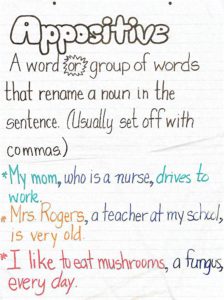
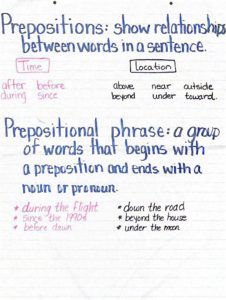
Once we have a basic understanding of prepositions and appositives, I either provide or have students fold a piece of paper into five rows. I ask the students to write a three or four-word simple 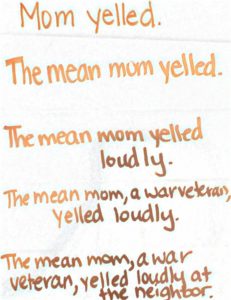 sentence. I model one and provide time for students to write one for themselves. Then I remind students that adjectives are words that describe and point to our adjective anchor chart. I ask students to write an adjective to describe their noun. Again, I model and allow time for the students to write their own. Next, I ask students to choose an adverb to describe the verb. Then I remind the students about appositive phrases and model for students how to rename my noun. This time I give a little more time for the students to complete this and I walk around to help. On the last row of their papers, I have students write a prepositional phrase. Here are my model example and a few student samples:
sentence. I model one and provide time for students to write one for themselves. Then I remind students that adjectives are words that describe and point to our adjective anchor chart. I ask students to write an adjective to describe their noun. Again, I model and allow time for the students to write their own. Next, I ask students to choose an adverb to describe the verb. Then I remind the students about appositive phrases and model for students how to rename my noun. This time I give a little more time for the students to complete this and I walk around to help. On the last row of their papers, I have students write a prepositional phrase. Here are my model example and a few student samples:
Once the students have done this activity a few times and are more comfortable adding adjectives, adverbs, appositive phrases, and prepositional phrases, we put in into context, which for me is the students’ own writing in a Writers’ Workshop. The students are used to working in their own writing, so I give them paper folded into five columns and ask them to take a simple sentence from their writing. Then they add an adjective to describe the noun that would make sense in the context of their composition, then they’ll add an adverb, the appositive phrase, and a prepositional phrase that would make sense for their paper. Once they finish, they’ll find a place to add it in their story. Viola!
Here are the student samples:
Contact me if you are interested in your campus learning more about Writers’ Workshop with Six Traits. Your teachers will leave with many strategies and activities that are sure to get students excited about writing!

